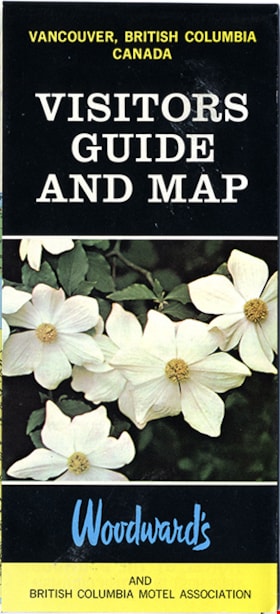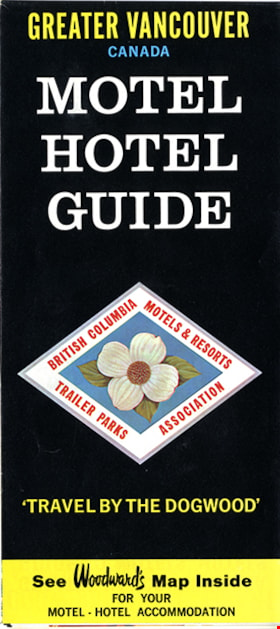Narrow Results By
Decade
- 2020s 22
- 2010s 24
- 2000s 33
- 1990s 31
- 1980s 37
- 1970s 53
- 1960s 40
- 1950s 42
- 1940s 52
- 1930s 66
- 1920s 27
- 1910s 29
- 1900s 21
- 1890s 11
- 1880s 5
- 1870s 4
- 1860s 1
- 1850s 1
- 1840s 1
- 1830s 2
- 1820s 1
- 1810s 1
- 1800s 1
- 1790s 1
- 1780s 1
- 1770s 1
- 1760s 1
- 1750s 1
- 1740s 1
- 1730s 1
- 1720s 1
- 1710s 1
- 1700s 1
- 1690s 1
- 1680s 1
- 1670s 1
- 1660s 1
- 1650s 1
- 1640s 1
- 1630s 1
- 1620s 1
- 1610s 1
- 1600s 1
Subject
- Advertising Medium 2
- Advertising Medium - Flyer 1
- Agriculture 2
- Agriculture - Farms 5
- Agriculture - Fruit and Berries 1
- Buildings 1
- Buildings - Civic - Museums 2
- Buildings - Commercial - General Stores 1
- Buildings - Commercial - Grocery Stores 1
- Buildings - Commercial - Restaurants 1
- Buildings - Heritage 3
- Buildings - Industrial - Factories 1
Creator
- Atchison, Topeka, and Santa Fe Railway Company 1
- Aujla, Kehar Singh 1
- Ballantyne, R. M. (Robert Michael), 1825-1894 1
- Ballentine, Teresa 1
- Baresh, Marta 1
- Belcastro, Arlene 1
- Binks, James 1
- Binning, Dr. Sadhu 1
- Birrell, A. J. 1
- Blakey Smith, Dorothy 1
- British Columbia. Bureau of Provincial Information 1
- Broadfoot, Anne, 1930- 1
Harold Edward Winch collection
https://search.heritageburnaby.ca/link/museumdescription3638
- Repository
- Burnaby Village Museum
- Date
- [1914]-2003
- Collection/Fonds
- Harold Edward Winch collection
- Description Level
- Fonds
- Physical Description
- approx. 23 cm of textual records + approx. 600 photographs (b&w + col.)
- Scope and Content
- Collection consists of records relating to Harold Edward Winch's family life and political career. It includes photographs of Winch's parents, family, and wife Jessie, as well as photographs, correspondence and other textual records from Harold's political work and experiences, a travel diary, gues…
- Repository
- Burnaby Village Museum
- Collection/Fonds
- Harold Edward Winch collection
- Description Level
- Fonds
- Physical Description
- approx. 23 cm of textual records + approx. 600 photographs (b&w + col.)
- Scope and Content
- Collection consists of records relating to Harold Edward Winch's family life and political career. It includes photographs of Winch's parents, family, and wife Jessie, as well as photographs, correspondence and other textual records from Harold's political work and experiences, a travel diary, guest books, and certificates. The collection includes a number of Co-operative Commonwealth Federation and New Democratic Party newspapers. The collection also includes records relating to Winch's death, such as obituaries, memorials, articles, and a guest book. Finally, the collection includes a small number of records relating to Winch's father, Ernie Winch, and his own political career. The collection has been arranged into five series: 1) Harold E. Winch biographical records (1933-2003) 2) Harold E. Winch photographs series (1914-[ca. 1990]) 3) Harold E. Winch political photograph album and records series ([1937]-1993) 4) Harold E. Winch personal records series (1949-1993) 5) Harold E. Winch newspaper collection series (1936-1986)
- History
- Harold Edward Winch (June 18, 1907-February 1, 1993) was born in Loughton, Essex, England to Ernest “Ernie” Edward Winch (March 22, 1879-January 11, 1957) and his wife Linda Marian (nee Hendy). Harold was the eldest of six children; the others were Eileen, Charlie, Grace, Alan, and Eric. Ernest moved to BC in 1909, followed by Linda, Harold, and Eileen in 1910. The remaining children were born in BC. Ernie, a brick mason, built the family a series of homes in the Lower Mainland as the family moved around for a number of years, living in Burnaby, White Rock, Mission, and Vancouver before finally settling back in Burnaby. Ernie Winch joined the Social Democratic Party of Canada in 1911 and became secretary of the party in 1913, and was heavily involved in trade unions and the labour and socialist movements. He helped re-establish the Socialist Party of Canada (BC) in 1932, which soon merged with the Co-operative Commonwealth Federation (CCF). Ernie was a CCF MLA in Burnaby from 1933 until his death in 1957, following which his son-in-law Cedric Cox (husband of Eileen) won the seat in a byelection. Ernie was particularly interested in institutions, including jails, mental hospitals, and industrial schools, and founded the New Vista Society in 1943 to provide a live-in rehabilitation program to women with psychiatric problems. The organization later expanded to focus on low-cost housing for seniors, and an apartment complex was built for this purpose in Burnaby. Both Ernie and Harold were lifelong members of the New Vista Society board of trustees. Harold Winch trained as an electrician, but also followed his father into politics, serving as a CCF MLA in Vancouver East from 1933 to 1953 – Ernie and Harold were two of the first seven CCF MLAs. The Winches set a Guinness world record for the longest father-and-son parliamentary tenure. Like his father, Harold was also highly involved in the labour movement, and acted as a liaison between workers and government during the Depression, particularly during the relief camp strike in Vancouver in 1935 which precipitated the On to Ottawa trek. He was the leader of the BC CCF from 1938 to 1953, and Leader of the Opposition from 1941 to 1953. In 1953, Harold stepped down from provincial politics to enter the federal arena, and served as a CCF MP for Vancouver East from 1953 to 1961, when the CCF became the New Democratic Party (NDP); Harold continued to serve as an NDP MP from 1961 to 1972, when he retired for health reasons. In federal office, Harold remained dedicated to the working class and humanitarian causes, issuing reports on subject such as unemployment, veterans’ rights, low-cost housing for seniors, animal welfare, drug addiction, and mental health concerns. Harold earned honorary law degrees from both UBC (1973) and SFU (1974). He was involved in numerous humanitarian and other organizations and his roles included president and treasurer of the Commonwealth Parliamentary Association; co-founder of the Immigrant Services Society of Vancouver; director of the Boag Foundation; and lifelong member of the Association for Protection of Fur Bearing Animals. Harold married Dorothy Ada Hutchinson (December 1, 1907-October 24, 1974) on May 11, 1929. They had three children: Donald, Gerald ("Jerry"), and Shirley. Following Dorothy’s death, Harold married Jessie Margaret Mendels (nee Sweezey) (June 29, 1913-May 9, 2006) on May 19, 1981. Jessie grew up in Grand Forks, BC, and her family moved to Vancouver when she was in high school. Her first husband was George Edward Mendels (November 2, 1905-September 2, 1978). She had no children. Jessie served as a St. John’s ambulance driver during World War II. She was also active in the CCF and NDP parties in BC, having been Provincial Secretary for the CCF in the 1940s, a vice-president of the party in the 1950s, and Provincial Secretary for the NDP in the 1960s. Like Harold, she later served as a director of the Boag Foundation. Jessie traveled widely throughout her life. The collection contains a small number of Jessie’s photographs. Harold Winch died in White Rock, where he and Jessie had retired, on February 1, 1993.
- Responsibility
- Winch, Harold Edward
- Accession Code
- BV013.12
- Date
- [1914]-2003
- Media Type
- Textual Record
- Photograph
- Arrangement
- Records within fonds have been arranged by subject and format.
- Notes
- Title based on contents of fonds
Harold E. Winch personal records series
https://search.heritageburnaby.ca/link/museumdescription3642
- Repository
- Burnaby Village Museum
- Date
- 1949-1993
- Collection/Fonds
- Harold Edward Winch collection
- Description Level
- Series
- Physical Description
- 6 cm of textual records
- Scope and Content
- Series consists of records relating to Harold Winch's personal life, including a travel diary, correspondence, certificates marking his achievements, and a guest book from his memorial.
- Repository
- Burnaby Village Museum
- Collection/Fonds
- Harold Edward Winch collection
- Description Level
- Series
- Physical Description
- 6 cm of textual records
- Scope and Content
- Series consists of records relating to Harold Winch's personal life, including a travel diary, correspondence, certificates marking his achievements, and a guest book from his memorial.
- Names
- Winch, Harold Edward
- Accession Code
- BV013.12
- Date
- 1949-1993
- Media Type
- Textual Record
- Notes
- Title based on contents of series
hatbox
https://search.heritageburnaby.ca/link/museumartifact80214
- Repository
- Burnaby Village Museum
- Accession Code
- BV009.1.5
- Description
- Trunk or travelling hatbox for up to six hats. The fiber board trunk is reinforced with leather binding at the seams. It has a carrying handle at the top and two straps and buckles at the front with a hasp at the centre. The lid is hinged at the back. The trunk is black with brown leather binding. The inside is lined with gray and white stripped fabric. The left corner of the lid is torn and the bottom of the trunk has suffered water damage. There are metal clips in each of the sides, bottom and inside of the lid to hold a frame for holding a hat. Up six hats could be accommodated with the hat crowns to the centre of the trunk. "A.S.H." is painted on the top of the trunk and there are travel stickers for "TRANS CANADA / AIR LINES", "ALLAN LINE", steamships and "SOUTHERN RAILWAY", in England. There are the remnants of other stickers on the trunk. Mrs. Hill travelled back and forth to England on several occasions, the last time in 1948 when she flew in her early 90's.
- Object History
- All items are from the L. Claude Hill family and are associated with Anne Sarah Hill (nee Kenrick) and Kitty Hill. Mrs. Hill travelled back and forth to England on several occasions, possibly in 1905 and again possibly in the 1920's. She travelled in 1931 and the last time in 1948 when she flew Trans Canada Airlines (TCA) in her early 90's
- Marks/Labels
- "ASH" is painted on the top of the trunk "TRANS CANADA / AIR LINES", travel sticker pasted on box "ALLAN LINE", travel sticker pasted on box (Allen steamships) "SOUTHERN RAILWAY", travel sticker pasted on box (Southern Railway in England.)
- Measurements
- Measurements: length 51.5 cm X width 40 cm and 40 cm deep all measured on outside.
Images
Interview with Ken Yip May 9, 2005 - Track 1
https://search.heritageburnaby.ca/link/museumdescription4531
- Repository
- Burnaby Village Museum
- Date
- 1950s & 1960s (interview content), interviewed May 9, 2005
- Collection/Fonds
- Burnaby Village Museum fonds
- Description Level
- Item
- Physical Description
- 1 sound recording (mp3) (0:13:37 min)
- Scope and Content
- Track 1: This portion of the recording pertains to Ken’s family responsibilities, school activities, and friends. Ken relates how his father received a veteran’s land grant after the Second World War, on Byrne Rd. in the Big Bend area of Burnaby, and how his family operated a market garden on the l…
- Repository
- Burnaby Village Museum
- Collection/Fonds
- Burnaby Village Museum fonds
- Series
- Museum Oral Histories series
- Subseries
- Growing Up in Burnaby subseries
- Description Level
- Item
- Physical Description
- 1 sound recording (mp3) (0:13:37 min)
- Material Details
- Interviewer: Tom Gooden Interviewee: Ken Yip Date of interview: May 9, 2005 Total Number of Tracks: 5 Total length of all Tracks: 0:62:00
- Scope and Content
- Track 1: This portion of the recording pertains to Ken’s family responsibilities, school activities, and friends. Ken relates how his father received a veteran’s land grant after the Second World War, on Byrne Rd. in the Big Bend area of Burnaby, and how his family operated a market garden on the land, selling their produce to Kelly Douglas, Woodward’s, and MacDonald’s Consolidated. Ken describes how he moved to North Burnaby in the early 1970s, near Sperling Ave. and Lougheed Hwy., and then to the Burnaby General Hospital area when he married a few years later. He speaks of attending Riverside Elementary School, McPherson Junior High School, and Burnaby South High School. Ken recalls having little free time as a child. He speaks of working on the farm after he finished his homework, and playing there with his brother. He describes his household chores, and the additional responsibilities he took on as he grew older and acquired more skills. Ken talks of being in the school band with his friends, their activities and travel and their trip to Montreal for Expo in 1967. He discusses his interests and his family’s expectations of him and his brother.
- History
- Recording of an interview with Ken Yip recording by Tom Gooden on May 9, 2005. This recording was completed for an exhibit, Growing Up in Burnaby, for the Burnaby Village Museum. Major themes discussed are growing up in Burnaby in the 1950s and 60s.
- Creator
- Burnaby Village Museum
- Subjects
- Persons - Veterans
- Names
- Yip, Ken
- McPherson Park Junior Secondary School
- Riverside Elementary School
- Burnaby South High School
- Accession Code
- BV017.45.5
- Access Restriction
- No restrictions
- Reproduction Restriction
- May be restricted by third party rights
- Date
- 1950s & 1960s (interview content), interviewed May 9, 2005
- Media Type
- Sound Recording
- Notes
- Title based on contents of item
Audio Tracks
Interview with Ken Yip May 9, 2005 - Track 1, 1950s & 1960s (interview content), interviewed May 9, 2005
Interview with Ken Yip May 9, 2005 - Track 1, 1950s & 1960s (interview content), interviewed May 9, 2005
https://search.heritageburnaby.ca/media/hpo/_Data/_BVM_Sound_Recordings/Oral_Histories/2017_0045_0005_001.mp3Interview with Prem Kaur Gill, Santokh Singh Gill and Mohinder Kaur Gill
https://search.heritageburnaby.ca/link/museumdescription19347
- Repository
- Burnaby Village Museum
- Date
- [1957-2022] (interview content), interviewed 11 Nov. 2022
- Collection/Fonds
- Burnaby Village Museum fonds
- Description Level
- Item
- Physical Description
- 1 sound recording (m4a) (118 min., 39 sec.) + 1 sound recording (mp3) (115 min., 20 sec.)
- Scope and Content
- Item consists of an oral history interview with Santokh "Gurmail" Singh Gill and Mohinder Kaur Gill and their daughter, Prem Kaur Gill conducted by interviewers, Anushay Malik and Rajdeep. The interview is conducted in English, Punjabi, Hindi and Urdu. The three members of the Gill family share the…
- Repository
- Burnaby Village Museum
- Collection/Fonds
- Burnaby Village Museum fonds
- Series
- Museum Oral Histories series
- Description Level
- Item
- Physical Description
- 1 sound recording (m4a) (118 min., 39 sec.) + 1 sound recording (mp3) (115 min., 20 sec.)
- Material Details
- Interviewers: Anushay Malik, Rajdeep Interviewees: Prem Kaur Gill, Santokh "Gurmail" Singh Gill and Mohinder Kaur Gill Location of Interview: Gill family residence on Warwick Avenue in Burnaby Interview Date: November 11, 2022 Total Number of tracks: 1 Total Length of all Tracks: (1:58:39) Digital master recording (m4a) was converted to mp3 for access on Heritage Burnaby
- Scope and Content
- Item consists of an oral history interview with Santokh "Gurmail" Singh Gill and Mohinder Kaur Gill and their daughter, Prem Kaur Gill conducted by interviewers, Anushay Malik and Rajdeep. The interview is conducted in English, Punjabi, Hindi and Urdu. The three members of the Gill family share their ancestral background, their personal experiences immigrating to Canada, living in Burnaby and working in British Columbia as South Asian immigrants. 00:00 – 27:34 Santokh “Gurmail” Singh Gill and Mohinder Kaur Gill share their migration stories and experiences living and working in British Columbia as South Asian immigrants and their eldest child, Prem Kaur Gill shares her own experiences as a child of South Asian immigrants and growing up in British Columbia as a South Asian Canadian. Gurmail Singh Gill was born in the District of Jalandhar and Mohinder Kaur Gill was born in Hoshiapur of the Indian state of Punjab. Gurmail describes how he moved from India to England with his family in 1957, immigrated to Canada from England in 1966, married his wife Mohinder in England in 1968 and brought his family (parents and two siblings) to Canada from England in 1970 and other relatives including his wife’s family in the 1970s and 1980s. Mohinder and Gurmail Gill recollect their arranged marriage in England in 1968, their immigration process and explain how they arrived in Burnaby residing with a cousin at 4649 Georgia Street until they were able to purchase their own home after a few years. Gurmail shares names and connections to the relatives that came to British Columbia before him. Gurmail and Mohinder tell how they lived in the basement of the house and rented out the upper floor to save money. The couple recall what they brought with them when they immigrated to Canada and Mohinder Kaur Gill tells of how before leaving India, she and her mother made a special rajai for her to take with her. Mohinder describes the process of making a rajai (a quilted blanket that was made by hand). Gurmail and Mohinder Gill talk about the challenges that they’ve experienced as new immigrants including not being fluent in English, the cold weather and not having very many family or friends nearby to provide support. They attended the Gurdwara on Ross Street or Akali Singh Sikh Society Gurdwara on Skeena in Vancouver. They explain how there was limited access to grocery stores that supplied Punjabi and Indian spices and other cooking supplies. They talk about how they used a food mill and mortar and pestle to grind their own spices and flour and how Mohinder often made traditional sweets like barfi and laddo and pakoras using pea flour when they couldn’t get Besan flour. 27:35 – 36:11 Gurmail provides more details on his family’s immigration story, including names of relatives, how his six siblings and parents all immigrated to British Columbia in 1970 and how in the early 1970s and mid 1980’s Gurmail and his family sponsored approximately 70 friends and relations from India (including Mohinder’s family) to immigrate to Canada. When Mohinder’s family arrived they lived with them in their house until they were able to purchase property next door and build their own home. Children in the families all attended elementary and high school in Burnaby which now amounts to three generations. 36:12 – 59:28 Gurmail and Mohinder Gill talk about their experiences of racial discrimination. Gurmail recalls members of the South Asian community, Dr. Hari Prakash Sharma, Harinder Mahil and Charan Gill starting the British Columbia Organization to Fight Racism. Gurmail tells of how he got involved contributing some of his union dues as a member of CAIMAW (Canadian Association of Industrial Mechanical and Allied Workers Union- Local 15) and as a friend of Charan Gill and Raj Chouhan of the Canadian Farm Workers Union. Gurmail Gill explains how he was a founding member of CAIMAW and treasurer until the union merged with the Canadian Auto Workers Union (in 1991). Mohinder and Gurmail tell of how people from the South Asian community were discouraged from wearing Punjabi dresses or head coverings for fear of being yelled at with racial slurs and how it was often scary to go outside. Many from their community often avoided attending the Akali Singh Gurdwara since a head covering was required and people were afraid of being a target. Gurmail provides details about his work with A1 Steel, how different unions were formed pertaining to various skillsets and jobs per company and how he became a member of CAIMAW Local 15 (foundry workers). Mohinder recollects her experiences as a mother, the daily tasks involved and friends that she made who’d also emigrated from Punjab. Mohinder describes how she designed and sewed many Punjabi dresses using her electric sewing machine and how she learned English by attending adult classes at a church on Commercial Drive. Mohinder and her mother attended the classes for two hours per day for six years at a cost of twelve dollars for ten weeks. Once Mohinder could speak a little English, she started working and was able to practice more. 59:29 – 1:06:08 Mohinder, Gurmail and Prem talk about some of their favourite traditional foods including corn roti and spinach curry and how they grow many of their own vegetables including peppers, eggplant, saag (spinach), onions, garlic, cilantro, zucchini, squash and fenugreek. Mohinder reflects on how access to Punjabi clothing and fabric stores in Vancouver has changed and that ready made food is now more available. Traditional foods were previously made from scratch with women gathering together and cooking for hours and now it’s gotten easier but more expensive and less of a community feel. 1:06:09- 1:55:20 Mohinder and Gurmail Gill discuss and share their perspectives and experiences on raising a family in the past versus today. Gurmail imparts that all of his siblings became educated and secured professional careers while he continued to work in the trades. Prem Kaur Gill shares her own experiences growing up and attending school in Burnaby. Gurmail and Mohinder Gill recall the type of suitcase that they brought with them when they immigrated and how they recently they got rid of it. Gurmail and the group reflect and discuss the confusion with racial identity terms that have been used in this country. They comment that South Asians were referred to as “Hindu” and “East Indian” and Indigenous peoples were referred to as “Indian” and the controversy and racism behind some of these terms. The group discusses the impact of the caste system and other discriminatory experiences and compare their experiences of living in England to living in Canada. Prem comments on how it’s just recently that South Asian customs, celebrations and practices have been recognized and celebrated here in Canada, like Diwali and yoga. They comment on how much of the language, culture and customs have been retained in Surrey where many can still communicate in Punjabi and don’t need to be fluent in English. The group discusses how many South Asians immigrants first lived and worked in Vancouver but with rising property prices many moved to Surrey expanding and establishing a much larger South Asian community with resources. The group discusses and compares the differing travel routes that many of them and their relatives took when immigrating and travelling between India and Canada. The group talks about Rajdeep’s ancestral village in India which is near the Gill village of Firozpur. Gurmail explains the origins and details behind his family name that was changed from “Shergill” to “Gill” and the name “Santokh” from his maternal side.
- History
- Interviewees' biographies: Santokh "Gurmail" Singh Gill was born in the District of Jalandhar in Punjab, India. Gurmail moved to England with his family in 1957 and immigrated to British Columbia in 1966. Gurmail married his wife, Mohinder Kaur Gill in England in 1968 and she immigrated to British Columbia from England soon after. Gurmail first lived with a cousin in Burnaby before purchasing a home of his own in Burnaby where he raised his family. Gurmail worked in the steel industry and was a member and treasurer of the CAIMAW before the union merged with the Canadian Auto Workers Union. Mohinder Kaur Gill was born in the Hoshiapur in Punjab, India. She married her husband Santokh "Gurmail" Singh Gill in England in 1968 and immigrated to Burnaby, British Columbia to join her husband. Mohinder and Gurmail Gill have four children, all born in Burnaby. Prem Kaur Gill was born in Burnaby in 1969 and is the eldest child of Santokh "Gurmail" Singh Gill and Mohinder Kaur Gill. Prem grew up and attended school in Burnaby. Interviewers' biographies: Anushay Malik is labor historian with a geographical focus on South Asia. Anushay studied at the University of London and was a research fellow at the International Institute of Social History in Amsterdam, Netherlands. In 2014, Anushay moved back to her native Pakistan and joined Lahore University of Management Services as an Assistant Professor. In 2023, Anushay is a visiting scholar at Simon Fraser University and lives in Burnaby with her family. Anushay was a co-curator of the Burnaby Village Museum exhibit “Truths Not Often Told: Being South Asian in Burnaby”. Rajdeep was born and raised in the Lower Mainland and is of Punjabi (South Asian) descent. She has an Associate of Arts degree in Asian Studies from Kwantlen Polytechnic University, a Bachelor of Arts (Hons.) in Anthropology from the University of British Columbia. She is a student in the Restoration of Natural Systems program at the University of Victoria. Rajdeep works at Simon Fraser University as a Program Assistant and as a researcher with the City of Burnaby. At Burnaby Village Museum, Rajdeep contributed to the exhibit “Truths Not Often Told: Being South Asian in Burnaby”.
- Creator
- Burnaby Village Museum
- Subjects
- Clothing
- Foods
- Indigenous peoples
- Buildings - Religious - Temples
- Food Processing Tools and Equipment
- Persons - South Asian Canadians
- Social Issues
- Social Issues - Racism
- Migration
- Occupations
- Organizations - Unions
- Responsibility
- Rajdeep
- Malik, Anushay
- Accession Code
- BV022.29.2
- Access Restriction
- No restrictions
- Reproduction Restriction
- No known restrictions
- Date
- [1957-2022] (interview content), interviewed 11 Nov. 2022
- Media Type
- Sound Recording
- Notes
- Title based on contents of item
- Transcript available upon request - contact Burnaby Village Museum
- Indian Family System Reference notes: Baba = informal way to say grandfather; old man Bibi = informal way to say grandmother; old woman Dada= paternal grandfather Dadi= paternal grandmother Dadke= paternal family members; paternal side (Various spellings might exist for the following terms) Thaiyya= father’s elder brother (uncle) Thaiyyi= father’s elder brother’s wife (aunt) Chacha= father’s younger brother (uncle) Chachi= father’s younger brother’s wife (aunt) Bua= father’s sister (older or younger) (aunt) Phuphar= father’s sister’s husband (uncle) Nana= maternal grandfather Nani= maternal grandmother Nanke/nanka= maternal family members; maternal side Mama= mom’s brother (older or younger) (uncle) Mami= mom’s brother’s wife (aunt) Maasi= mom’s sister (older or younger) (aunt) Maasard= mom’s sister’s husband (uncle)
Audio Tracks
Interview with Prem Kaur Gill, Santokh Singh Gill and Mohinder Kaur Gill, [1957-2022] (interview content), interviewed 11 Nov. 2022
Interview with Prem Kaur Gill, Santokh Singh Gill and Mohinder Kaur Gill, [1957-2022] (interview content), interviewed 11 Nov. 2022
https://search.heritageburnaby.ca/media/hpo/_Data/_BVM_Sound_Recordings/Oral_Histories/2022_0029_0002_002.mp3Interview with Shushma Datt and Sudhir Datta
https://search.heritageburnaby.ca/link/museumdescription19611
- Repository
- Burnaby Village Museum
- Date
- [1946- 2023] (interview content), interviewed 20 Jan. 2023
- Collection/Fonds
- Burnaby Village Museum fonds
- Description Level
- Item
- Physical Description
- 2 sound recordings (wav) (90 min., 21 sec.) + 1 sound recording (mp3) (90 min., 4 sec.)
- Scope and Content
- Item consists of a recording of an oral history interview with Shushma Datt and her son, Sudhir Datta conducted by Burnaby Village Museum Curator, Jane Lemke and Anushay Malik. 00:00 – 12:47 Interview opens with introductions. Shushma Datt shares information about; where she’s lived in Burnaby sin…
- Repository
- Burnaby Village Museum
- Collection/Fonds
- Burnaby Village Museum fonds
- Series
- Museum Oral Histories series
- Description Level
- Item
- Physical Description
- 2 sound recordings (wav) (90 min., 21 sec.) + 1 sound recording (mp3) (90 min., 4 sec.)
- Material Details
- Interviewers: Jane Lemke and Anushay Malik Interviewees: Shushma Datt and Sudhir Datta Location of Interview: Spice Radio, Norland Avenue, Burnaby Interview Date: January 20, 2023 Total Number of tracks: 2 Total Length of all Tracks: 01:30:21 Digital master recordings (wav) were edited into one recording and converted to mp3 for access on Heritage Burnaby
- Scope and Content
- Item consists of a recording of an oral history interview with Shushma Datt and her son, Sudhir Datta conducted by Burnaby Village Museum Curator, Jane Lemke and Anushay Malik. 00:00 – 12:47 Interview opens with introductions. Shushma Datt shares information about; where she’s lived in Burnaby since immigrating in 1972 and her arranged marriage which lead her to immigrate to Canada. Datt provides detailed information about her family background in Kenya and her parent’s decision to move their family from Kenya to India in the 1960s and then to England in the 1965. Datt describes her family’s experiences living in Kenya and India in the 1960s and provides some context on the political unrest that happened in Kenya which lead her family to leave. 12:48 - 28:07 Datt talks about her time living in England and shares information on her family life and her employment experiences. Datt conveys an experience from her childhood that inspired her to become a broadcaster and shares her experiences working for the BBC oversees service in England (1965-1972). Datt describes some of the articles that she's written for various publications and the people that she's interviewed. Datt highlights a particular experience about writing a critical review about the controversial design on Jimi Hendrix’s album “Axis: Bold as Love” that depicted Hindu religious iconography. 28:09 – 34:47 Datt and Datta provide further details about Datt's arranged marriage which lead her to immigrate to Canada in 1972 and to work as a broadcaster in Canada. Datt recalls her experiences working as a radio station operator for CHQM, a radio broadcaster for CJVB and starting her own South Asian radio station Rim Jhim in 1987. 34:48 – 40:01 Datt and Datta share information on where they’ve lived in Vancouver and Burnaby. Datt and Datta recall pivotal family life events that impacted their lives in 1974. 40:02 – 45:53 Datt recalls the travel trunks and contents that she and her family brought with them when they left Nairobi. Datt describes the letters that her parents wrote. Datt and Datta describe photos of their family and convey the impacts to their family after two of Datt’s brothers died at 24 years of age. 45:54 – 50:56 Interview continues chronologically from 1974, after Datt’s son, Sudhir Datta was born. Datt describes how she had to work hard to help pay her bills and support her family. Datta describes his childhood growing up as a South Asian child living and attending school in Burnaby (1979-1992). Datt and Datta recall Datt’s graduation ceremony and Datta’s Order of British Columbia awards ceremony. 50:57 – 58:03 Datt and Datta talk about food and cooking and where they’ve shopped for traditional food supplies. Datta explains her family lineage as Hindus who eat meat and how she’s been a vegetarian for over 30 years. Datt and Datta share stories about Datt’s mother Leela Datta. 58:04 – 1:05:38 Both Datt and Datta reflect on what’s it’s been like living as South Asians in Burnaby. Datt conveys the message that she got from her mom, Leela Datta "not to assimilate but to integrate". They both reflect on how the ethnic and cultural diversity of neighbourhoods has changed over time and Datt describes his experiences as a student in Burnaby. 1:05:39 – 1:16:51 Datt and Datta talk about the role of religion in their lives, describe the purpose of Radio Rim Jhim and reflect on how the South Asian community has grown in Metro Vancouver and the disparities created within. They both recall how their lives were threatened and impacted in 1984 following an interview that Datt did with Indira Ghandhi. Datt talks about the origins of her and her son’s surnames. 1:16:52 – 1:26:11 Datt and Datta talk about and reflect on their own experiences of racism and discrimination. Datt talks about Spice Radio’s annual campaign “Raise your hands against Racism”. Datt and Datta provide background on the radio stations Rim Jhim and Spice Radio including; how they got started, their unbiased approach to broadcast content and their experiences in the complex realm of broadcasting a multi-cultural radio station. 1:26:12 – 1:30:04 In closing, Datt and Datta convey what they think that younger generations of South Asian Canadians should understand about the South Asian Community in British Columbia.
- History
- Interviewees biographies: Shushma Datt was born in Nairobi, Kenya in 1946 and is the second eldest of six children. In the 1960s during the unrest in Kenya, her family moved to India. After about nine months of living in India, Datt's family decided to return to Kenya, leaving Datt and her brother to complete their education in India. While living in India, Datt studied at Delhi University and worked at the Indian newspaper. In 1965, Datt, her parents and five siblings decided to leave Kenya and immigrated to England. While living in England, Datt got work as a broadcaster with the British Broadcasting Corporation (BBC) overseas service, producing her first program in 1969. During her time with the BBC, Datt has interviewed many influential artists including Jimi Hendrix and the Beatles as well as the Prime Minister of India, Indira Gandhi. In 1972, Datt immigrated to Canada and settled in Burnaby. In late 1973, Datt sponsored her mother who joined her in Burnaby. Datt joined the CJVB radio station in Vancouver working as the Punjabi and Hindi language broadcaster. Datt worked here until 1978 when she started her own radio station, Radio Rim Jhim. In 2005, Datt obtained her own AM radio band license for a multicultural radio station RJ1200 which was later rebranded "Spice Radio". In 2015, Datt launched Spice Radio's annual "Hands Against Racism" campaign which has won awards from the Government of British Columbia and the B.C. Association of Broadcasters. Datt has also been a producer for Omni TV and Shaw TV and was the first woman to obtain a broadcasting license from the Canadian Radio- Television Telecommunications Commission. In 1992, Shushma Datt was awarded the Order of British Columbia and is also the recipient of the Queen's Golden Jubilee Medal. Datt has been listed by the Vancouver Sun newspaper as among the 100 "most influential Indo-Canadians" and has been recognized by the Royal British Columbia Museum as one of the 150 "most influential British Columbians". Sudhir Datta is the only child of Sushma Datt and was born in Burnaby. Datta graduated with a computer science degree from Capilano University in 1995. Datta is the Vice President of Media Broadcasting (founded in 1984) creating television and radio programming for Canada's South Asian Community and has been the General Manager and Program Director of Spice Radio since 2006. Datta is also the author of many articles highlighting the South Asian community in Vancouver. Interviewers biographies: Anushay Malik is labor historian with a geographical focus on South Asia. Anushay studied at the University of London and was a research fellow at the International Institute of Social History in Amsterdam, Netherlands. In 2014, Anushay moved back to her native Pakistan and joined Lahore University of Management Services as an Assistant Professor. In 2023, Anushay is a visiting scholar at Simon Fraser University and lives in Burnaby with her family. Anushay was a co-curator of the Burnaby Village Museum exhibit “Truths Not Often Told: Being South Asian in Burnaby”. Jane Lemke has worked in various museums in the Lower Mainland and has been the Curator at Burnaby Village Museum since 2019. Her educational background includes a Master of Arts degree in History and a Master of Museum Studies degree. Her research focus has been on trauma and memory and its role in shaping Canadian identity. She loves sharing memories and stories of Burnaby with the public. Jane sits on the Council of the BC Museums Association and is the Chair of the BC Museums Association Professional Development and Education Committee.
- Creator
- Burnaby Village Museum
- Subjects
- Migration
- Occupations - Broadcasters
- Occupations - Entrepreneurs
- Occupations - Journalists
- Persons - South Asian Canadians
- Radio Stations
- Religions
- Religions - Hinduism
- Religions - Sikhism
- Social Issues
- Social Issues - Racism
- Responsibility
- Malik, Anushay
- Lemke, Jane
- Accession Code
- BV023.1.3
- Access Restriction
- No restrictions
- Reproduction Restriction
- No known restrictions
- Date
- [1946- 2023] (interview content), interviewed 20 Jan. 2023
- Media Type
- Sound Recording
- Notes
- Title based on contents of item
- Transcript available upon request
Audio Tracks
Interview with Shushma Datt and Sudhir Datta, [1946- 2023] (interview content), interviewed 20 Jan. 2023
Interview with Shushma Datt and Sudhir Datta, [1946- 2023] (interview content), interviewed 20 Jan. 2023
https://search.heritageburnaby.ca/media/hpo/_Data/_BVM_Sound_Recordings/Oral_Histories/2023_0001_0003_003.mp3It Took a While to Get There
https://search.heritageburnaby.ca/link/museumdescription10097
- Repository
- Burnaby Village Museum
- Date
- 2016
- Collection/Fonds
- Burnaby Village Museum Film and Video collection
- Description Level
- Item
- Physical Description
- 1 video recording (mp4) (4 min., 40 sec.) : digital, 25 fps, col., sd., stereo
- Scope and Content
- Kathryn Small has lived in Burnaby almost her entire life. In this video she recounts the path she travelled before finding the 27 year career she settled on and from which she retired in 2008. Having faced discrimination (because she was a woman) which blocked her entering her first choice for a…
- Repository
- Burnaby Village Museum
- Collection/Fonds
- Burnaby Village Museum Film and Video collection
- Description Level
- Item
- Physical Description
- 1 video recording (mp4) (4 min., 40 sec.) : digital, 25 fps, col., sd., stereo
- Scope and Content
- Kathryn Small has lived in Burnaby almost her entire life. In this video she recounts the path she travelled before finding the 27 year career she settled on and from which she retired in 2008. Having faced discrimination (because she was a woman) which blocked her entering her first choice for a career, Kathryn found that her subsequent variety of education and experiences over the next decade well-fitted her for her “life’s work”. Kathryn is convinced that all and any education and experience can play a part in preparing one for one’s chosen career. She is also glad that today discrimination based on gender is finally illegal in Canada. That the title of this video is an intentional double-entendre is evident by the end of the video.
- History
- Kathryn Small has a long connection to Burnaby, her grandparents having settled in the Douglas Road area in 1921 and her parents choosing to live in the same area. Kathryn attended Douglas Road Elementary School and graduated from Burnaby Central High School. After a variety of post-secondary education, work and travel experiences, she then worked for 27 years in Burnaby as a Public Health Inspector/Environmental Health Officer before retiring in 2008. Kathryn still lives in Burnaby.
- Creator
- Small, Kathryn
- Other Title Information
- title supplied by film maker
- Names
- Small, Kathryn
- Geographic Access
- Douglas Road
- Accession Code
- BV016.37.5
- Access Restriction
- No restrictions
- Reproduction Restriction
- May be restricted by third party rights
- Date
- 2016
- Media Type
- Moving Images
- Notes
- Transcribed title
Images
Video
It Took a While to Get There, 2016
It Took a While to Get There, 2016
https://search.heritageburnaby.ca/media/hpo/_Data/_BVM_Moving_Images/2016_0037_0005_001.mp4Jack and Edith with Aunt Rita on boat
https://search.heritageburnaby.ca/link/museumdescription5143
- Repository
- Burnaby Village Museum
- Date
- [1939]
- Collection/Fonds
- Waplington family fonds
- Description Level
- Item
- Physical Description
- 1 photograph : b&w ; 12.5 x 8.5 cm
- Scope and Content
- Photograph of Jack and Edith Fleming with their aunt Rita and Frances Nicherson on board the Fleming family boat, "Cohoe Bay" on top of the wheel house as they travel up Indian Arm.
- Repository
- Burnaby Village Museum
- Collection/Fonds
- Waplington family fonds
- Description Level
- Item
- Physical Description
- 1 photograph : b&w ; 12.5 x 8.5 cm
- Scope and Content
- Photograph of Jack and Edith Fleming with their aunt Rita and Frances Nicherson on board the Fleming family boat, "Cohoe Bay" on top of the wheel house as they travel up Indian Arm.
- Subjects
- Transportation - Boats
- Accession Code
- BV016.46.98
- Access Restriction
- No restrictions
- Reproduction Restriction
- No known restrictions
- Date
- [1939]
- Media Type
- Photograph
- Scan Resolution
- 600
- Scan Date
- 13-Aug-2018
- Notes
- Title based on information on verso of photograph
- Note in pencil on verso of photograph reads: "Jack Fleming / Rita / Edie Fleming / Frances Nicherson / up Indian / Arm / Aboard the / Cohoe Bay"
- Photograph is part of Photograph album BV016.46.52
Images
leaflet
https://search.heritageburnaby.ca/link/museumartifact34876
- Repository
- Burnaby Village Museum
- Accession Code
- BV993.10.7
- Description
- Passport to Burnaby - Leaflet -- [1992]. A commemorative leaflet as part of the Burnaby Centennial Celebration. The goal was to promote travel to host centres to receive a stamp as part of a passport. When all stamps were collected the page could be entered into a draw. Participating Host Centres were C.G. Brown Memorial Swimming Pool, Cameron Recreation Centre, Confederation Centre, Burnaby Mountain Golf Course, Burnaby Municipal Hall, Burnaby Village Museum, Bob Prittie Metrotown Branch, The Burnaby Arts Centre, Still Creek Recycling Depot, and Bonsor Recreation Complex. The passport has been stamped for Burnaby Municipal Hall. The leaflet was produced by the Finance Department and the Centennial Committee. The leaflet measures 28cm x 21.5cm.
- Title
- Passport to Burnaby
- Subjects
- Documentary Artifacts
- Documentary Artifacts - Leaflets
- Celebrations
- Celebrations - Centennials
Images
Learnings from the pandemic
https://search.heritageburnaby.ca/link/museumdescription14748
- Repository
- Burnaby Village Museum
- Date
- Aug. 2020
- Collection/Fonds
- Burnaby Village Museum COVID-19 collection
- Description Level
- File
- Physical Description
- 3 photographs (tiff) : col. ; 72 dpi.
- Scope and Content
- File consists of photographs of screenshots taken from an iPhone Apple Notes text application. The photographs consist of a piece of writing reflecting on the learnings of COVID-19 by Yimeng (Jane) Zhao. A transcription of the written work reads: "Before pandemic ¦Synchronization¦ The moment whe…
- Repository
- Burnaby Village Museum
- Collection/Fonds
- Burnaby Village Museum COVID-19 collection
- Description Level
- File
- Physical Description
- 3 photographs (tiff) : col. ; 72 dpi.
- Scope and Content
- File consists of photographs of screenshots taken from an iPhone Apple Notes text application. The photographs consist of a piece of writing reflecting on the learnings of COVID-19 by Yimeng (Jane) Zhao. A transcription of the written work reads: "Before pandemic ¦Synchronization¦ The moment when your local cafe plays the same song as you're listening to on your headphones When you arrive for your date with the girls and end up matching by accident After getting a new lipstick it made you decide to finally make the move (travel to a new place, land your dream job) Posted a similar WeChat moment/Instagram story as your dudes/gals When you walk into the men's washroom by accident then at the guitar class They taught you the song "yellow" during... Learnings 1. Drilling helps you relieve wrists pains especially if you are tech-addict or journal writers 2. Sudden stopping on the car happens often, don't forget the safety belts 3. Never ride with a complete strange driver unless you're with someone you trust 4. Don't pick wild flowers no matter how small they are 5. Put things back to where you found them 6. Your folks are just like children, spending time to listen 7. Slow to anger. Always respect 8. Smile 9. #blackoutTuesday 10. Your index finger can work wonders 11. So can a stylus 12. Try before actually buying/returning 13. Think before speaking/answering 14. Just do it 15. Action speak louder than words 16. Let music speak 17. A picture is worth a thousand words 18. Words can be weapons 19. #createdonthate 20. Do not take anything for granted 21. Family first 22. Don't cry or get angry if it doesn't help the situation 23. Laughing out loud cures mild depressed moods 24. So does exercise 25. And culinary arts 26. Painting/sketching too 27. Journal the things you want to complain, but be grateful for all that comes 28. Pray 29. Used aroma therapy 30. CBT 31. Eye drops are cheesy p"
- Creator
- Zhao, Yimeng (Jane)
- Subjects
- Pandemics - COVID-19
- Accession Code
- BV020.23.1
- Access Restriction
- No restrictions
- Reproduction Restriction
- No known restrictions
- Date
- Aug. 2020
- Media Type
- Photograph
- Notes
- Title based on content of photographs
Images
The Lee Block on Government Street.
https://search.heritageburnaby.ca/link/museumdescription9388
- Repository
- Burnaby Village Museum
- Date
- 1975
- Collection/Fonds
- Way Sang Yuen Wat Kee & Co. fonds
- Description Level
- Item
- Physical Description
- 1 photograph : b&w; 17.5 x 23 cm
- Scope and Content
- Photograph of a three story brick building on a main street. The building has been identified as the Lee Block, 1618-1628 Government Street at the corner of Government as Fisgard in Victoria. One of the business is Bayshor Travel. "Lum Sai Ho Ass'n" written in Chinese characters on the storefront …
- Repository
- Burnaby Village Museum
- Collection/Fonds
- Way Sang Yuen Wat Kee & Co. fonds
- Description Level
- Item
- Physical Description
- 1 photograph : b&w; 17.5 x 23 cm
- Scope and Content
- Photograph of a three story brick building on a main street. The building has been identified as the Lee Block, 1618-1628 Government Street at the corner of Government as Fisgard in Victoria. One of the business is Bayshor Travel. "Lum Sai Ho Ass'n" written in Chinese characters on the storefront of the shop fourth from the left. The front window has some pottery displayed and the address, 1624 . In front of the business a station wagon is parked and there is a someone giving it a ticket. Next to that store is one called "China Commodity /All Products from Peoples Republic of China." The front windows display plates and other pottery.
- Geographic Access
- Victoria
- Accession Code
- BV017.7.198
- Access Restriction
- No restrictions
- Reproduction Restriction
- No known restrictions
- Date
- 1975
- Media Type
- Photograph
- Scan Resolution
- 300
- Scan Date
- 29-Jul-2018
- Scale
- 96
- Notes
- Title based on contents of photograph
Images
Letter from Brigadeer Colin Fox to May Bateman
https://search.heritageburnaby.ca/link/museumdescription15129
- Repository
- Burnaby Village Museum
- Date
- 8 Aug. 1943
- Collection/Fonds
- E.W. Bateman family fonds
- Description Level
- Item
- Physical Description
- 2 p. + envelope
- Scope and Content
- Item consists of a letter written by Colin Rhodes Fox of the Royal Canadian Artillery Service to his aunt Marianne "May" Bateman while serving overseas during World War II. Colin Fox served in the 13th Canadian Field Regiment, 44th Canadian Field Battery. Letter is written on Salvation Army station…
- Repository
- Burnaby Village Museum
- Collection/Fonds
- E.W. Bateman family fonds
- Description Level
- Item
- Physical Description
- 2 p. + envelope
- Scope and Content
- Item consists of a letter written by Colin Rhodes Fox of the Royal Canadian Artillery Service to his aunt Marianne "May" Bateman while serving overseas during World War II. Colin Fox served in the 13th Canadian Field Regiment, 44th Canadian Field Battery. Letter is written on Salvation Army stationery. In his letter, Colin describes his time on leave that he spent in London; tells of how he plans to travel to Scotland on his next leave and letters and parcels that he's received from family members.
- Accession Code
- BV020.27.17
- Access Restriction
- Restricted access
- Reproduction Restriction
- May be restricted by third party rights
- Date
- 8 Aug. 1943
- Media Type
- Textual Record
- Scan Resolution
- 600
- Scan Date
- 10-Feb-2021
- Scale
- 100
- Notes
- Title based on contents of item
- Stationery insignia in red ink on envelope and writing paper reads: logo of "The Salvation Army" / with the Canadian Active Service Forces" + logo of "The Salvation Army" / "Keep in touch with the folks at home" / ON ACTIVE SERVICE / with the / CANADIAN FORCES"
- Address on front of envelope reads: "Miss M. Bateman / 3896 W. 25th Ave. / Vancouver B.C. / Canada"
- Return address on verso of envelope reads: "K 19022 Bdr. C.R.Fox / 44th Fld. Bty. / 13th Fld. Reg't. R.C.A. A.F. / Canadian Army Overseas"
- Stamp in blue ink on outside cover of air mail letter reads: "13 FD. RECT. R.C.A. / OUT GOING MAIL"
- Circular post mark stamp on front of envelope reads: "FIELD POST OFFICE 484 / AU 9 / 43"
- Typewritten note on back of page one reads: "Thought you might like / to read this; will you/ please send it back / as I'll be answering / it one of these days"
Images
Letter from Colin Fox to his mother
https://search.heritageburnaby.ca/link/museumdescription15156
- Repository
- Burnaby Village Museum
- Date
- June 1944
- Collection/Fonds
- E.W. Bateman family fonds
- Description Level
- Item
- Physical Description
- 2 p.
- Scope and Content
- Items consists of a typewritten letter from Sergeant Colin Rhodes Fox to his mother, Jessie (Bateman) Fox. The letter is written on stationery with the letterhead "CANADIAN PACIFIC RAILWAY COMPANY" and references "... Colin's letter dated June 26". Colin is writing from hospital after being wounded…
- Repository
- Burnaby Village Museum
- Collection/Fonds
- E.W. Bateman family fonds
- Description Level
- Item
- Physical Description
- 2 p.
- Scope and Content
- Items consists of a typewritten letter from Sergeant Colin Rhodes Fox to his mother, Jessie (Bateman) Fox. The letter is written on stationery with the letterhead "CANADIAN PACIFIC RAILWAY COMPANY" and references "... Colin's letter dated June 26". Colin is writing from hospital after being wounded while laying communication cable from the Normandy beachhead on June 8, 1944 (two days after D-Day). In the letter, Colin tells his mother of his current condition in hospital, describing the wounds that he sustained and how much of his belongings are still with his regiment.
- Accession Code
- BV020.27.43
- Access Restriction
- Restricted access
- Reproduction Restriction
- May be restricted by third party rights
- Date
- June 1944
- Media Type
- Textual Record
- Scan Resolution
- 600
- Scan Date
- 10-Feb-2021
- Scale
- 100
- Notes
- Title based on contents of item
- Stationery letterhead reads: "CANADIAN PACIFIC RAILWAY COMPANY / FILE OR CLAIM / FORM 101.." includes logo which reads: "CANADIAN PACIFIC / RAILWAY / STEAMSHIPS / COMMUNICATIONS / HOTELS . / EXPRESS / WORLD'S / GREATEST / TRAVEL SYSTEM"
Letter from Jesse Love to Dot Love
https://search.heritageburnaby.ca/link/museumdescription3033
- Repository
- Burnaby Village Museum
- Date
- [1910] (date of original), photographed 1979
- Collection/Fonds
- Love family fonds
- Description Level
- Item
- Physical Description
- 1 photograph : b&w print ; 25.4 x 20.2 cm
- Scope and Content
- Photograph of the first page of a two page letter written by Jesse Love to his daughter Martha (Dot) Love. Jesse Love wrote the letter from Toronto to tell his daughter about his travel in Ontario and Quebec. The letter is dated 21 August 1910 on the first page, and the original letter has creases …
- Repository
- Burnaby Village Museum
- Collection/Fonds
- Love family fonds
- Description Level
- Item
- Physical Description
- 1 photograph : b&w print ; 25.4 x 20.2 cm
- Scope and Content
- Photograph of the first page of a two page letter written by Jesse Love to his daughter Martha (Dot) Love. Jesse Love wrote the letter from Toronto to tell his daughter about his travel in Ontario and Quebec. The letter is dated 21 August 1910 on the first page, and the original letter has creases from being folded.
- Accession Code
- HV979.40.4
- Access Restriction
- No restrictions
- Reproduction Restriction
- No known restrictions
- Date
- [1910] (date of original), photographed 1979
- Media Type
- Photograph
- Related Material
- To see the second page of this letter, see HV979.40.5
- Scan Resolution
- 600
- Scan Date
- 2023-09-12
- Notes
- Title based on contents of photograph
Images
Letter from Jesse Love to Dot Love
https://search.heritageburnaby.ca/link/museumdescription3034
- Repository
- Burnaby Village Museum
- Date
- [1910] (date of original), photographed 1979
- Collection/Fonds
- Love family fonds
- Description Level
- Item
- Physical Description
- 1 photograph : b&w print ; 25.5 x 20.2 cm
- Scope and Content
- Photograph documents the second page of a two page letter written by Jesse Love to his daughter Martha (Dot) Love. Jesse Love wrote the letter from Toronto to tell his daughter about his travel in Ontario and Quebec. The letter is dated 21 August 1910 on the first page, and the original letter has …
- Repository
- Burnaby Village Museum
- Collection/Fonds
- Love family fonds
- Description Level
- Item
- Physical Description
- 1 photograph : b&w print ; 25.5 x 20.2 cm
- Scope and Content
- Photograph documents the second page of a two page letter written by Jesse Love to his daughter Martha (Dot) Love. Jesse Love wrote the letter from Toronto to tell his daughter about his travel in Ontario and Quebec. The letter is dated 21 August 1910 on the first page, and the original letter has creases from being folded.
- Accession Code
- HV979.40.5
- Access Restriction
- No restrictions
- Reproduction Restriction
- No known restrictions
- Date
- [1910] (date of original), photographed 1979
- Media Type
- Photograph
- Related Material
- To see the first page of this letter, see HV979.40.4
- Scan Resolution
- 600
- Scan Date
- 2023-09-12
- Notes
- Title based on contents of photograph
Images
map
https://search.heritageburnaby.ca/link/museumartifact91126
- Repository
- Burnaby Village Museum
- Accession Code
- BV011.44.10
- Description
- map brochure; cover on one side reads "VANCOUVER, BRITISH COLUMBIA / CANADA / VISITORS / GUIDE / AND MAP" and the other side reads: "GREATER VANCOUVER / CANADA / MOTEL / HOTEL / GUIDE / TRAVEL BY THE DOGOOD'" and includes the logo for "British Columbia / Motels & Resorts / Trailer Parks / Association" with dogwood in centre. One side of fold-out includes map titled "Guide Map of Greater Vancouver / Woodwards" and includes inset map of Downtown Vancouver and Stanley Park and inset map of Lower Mainland and Fraser Valley Vancouver and Vicinity along with a list of Greater Vanouver Area Motels and Hotels. The other side of the fold-out includes colour adds for tourist sites and amenities in Greater Vancouver including Capilano Suspension bridge; Heritage Village, Burnaby, B.C.; MacMillan Planetarium; Bloedel Conservatory; Grouse Mountain; Gastown; The Ship of the Seven Seas restaurant and Woodwards stores and shopping centres. Map was published in the public interest by Woodward's (Lower Mainland) department stores; B.C. Motels and Resorts Association Branch "C" whose members appear on the map inside.
- Category
- 08. Communication Artifacts
- Classification
- Documentary Artifacts - - Graphic Documents
- Object Term
- Cartograph, Map
- Measurements
- 45.5 x 70 cm folded to 22.5 x 10 cm
- Country Made
- Canada
- Geographic Access
- Vancouver
Images
The New Testament of Our Lord and Saviour Jesus Christ : translated out of the original Greek, and with the former translations diligently compared and revised by His Majesty's special command
https://search.heritageburnaby.ca/link/museumlibrary2578
- Repository
- Burnaby Village Museum
- Collection
- Special Collection
- Material Type
- Book
- Accession Code
- HV975.74.21
- Call Number
- 225.52 NAT
- Place of Publication
- Edinburgh
- Publisher
- National Bible Society of Scotland
- Publication Date
- 1886
- Physical Description
- 464, 108 p. ; 11 cm.
- Inscription
- Front endpaper: "1914 [picture of British flag] 1915 'Be strong and of a good courage, for the Lord thy God is with thee wither- soever thou goest' Pte. A.A. A.A MacNaughton 54 1/2 Homewood Ave Toronto, Ont Canada On Active Service Issued by the NATIONAL BIBLE SOCIETY OF SCOTLAND" [printed in blue ink on a white sticker, except for name and address, which is handwritten in brown ink] Front fly leaf: handwritten notes detailing travel dates and destinations, written in brown and purple ink
- Library Subject (LOC)
- Bible. New Testament
- Christianity
- Psalms (Music)
- Bible
- Notes
- "appointed to be read in churches" -- t.p.
- includes "The Psalms of David in metre; according to the version approved by the Church of England, and appointed to be used in worship"
Nu-tka : Captain Cook and the Spanish explorers on the coast
https://search.heritageburnaby.ca/link/museumlibrary7469
- Repository
- Burnaby Village Museum
- Collection
- Reference Collection
- Material Type
- Textual Record
- Call Number
- 970 NUT v. 7, no. 1
- Contributor
- Efrat, Barbara S., 1935-2017
- Langlois, W. J., 1949-
- Place of Publication
- Victoria, British Columbia
- Publisher
- Aural History Program, Ministry of Provincial Secretary and Travel Industry, Provincial Archives of B.C.
- Publication Date
- 1978
- Series
- Sound heritage; v. 7, no.1
- Library Subject (LOC)
- Cook, James, 1728-1779
- Nootka Indians--History
- Indigenous peoples--British Columbia--History
- Oral history
- Oral history--British Columbia
- British Columbia--History
- Botany
- Plants, Useful--British Columbia --History
- Periodicals
- Notes
- "Edited by Barbara S. Efrat and W.J. Langlois." -- title page
- "The editors of this volume have chosen to emphasize the linguistic spelling of the word Nootka. The word NU-TKA means " circling about" and is explained in detail by the excellent account of Mrs. Winifred David on page 55. " -- title page
- "This volume is the first part of a two-part series to commemorate the Captain Cook Bicentennial. It is the intent of the editors that the two volumes should form one unit. The second volume Nu-tka : the history and survival of Nootkan culture will follow in short order . W.J.L. " -- title page
- Includes bibliographical references
Nu-tka : the history and survival of Nootkan culture
https://search.heritageburnaby.ca/link/museumlibrary7468
- Repository
- Burnaby Village Museum
- Collection
- Reference Collection
- Material Type
- Textual Record
- Call Number
- 970 NUT v. 7, no. 2
- Contributor
- Efrat, Barbara S., 1935-2017
- Langlois, W. J., 1949-
- Place of Publication
- Victoria, British Columbia
- Publisher
- Aural History Program, Ministry of Provincial Secretary and Travel Industry, Provincial Archives of B.C.
- Publication Date
- 1978
- Series
- Sound heritage; v. 7, no. 2
- Printer
- K.M. MacDonald, Queen's Printer
- Physical Description
- 65 p. : ill. (some col.), map ; 27 cm.
- Library Subject (LOC)
- Nootka Indians--History
- Nootka Indians--Social life and customs
- Indigenous peoples--British Columbia--Vancouver Island
- British Columbia--Vancouver Island
- Indigenous peoples--British Columbia--History
- Oral history
- Oral history--British Columbia
- British Columbia--History
- Periodicals
- Notes
- "Edited by Barbara S. Efrat and W.J. Langlois." -- title page
- "This volume is the second part of a two-part series to commemorate the Captain Cook Bicentennial. It is the intent of the editors that the two volumes should form one unit. The first volume Nu-tka : Captain Cook and the Spanish Explorers on the Coast provides historical background on the contact period. W.J.L. " -- title page
Oral history interview with Hipman "Jimmy" Chow and Donna Polos
https://search.heritageburnaby.ca/link/museumdescription19146
- Repository
- Burnaby Village Museum
- Date
- 29 Jun. 2022
- Collection/Fonds
- Hipman "Jimmy" Chow and Donna Polos fonds
- Description Level
- Item
- Physical Description
- 3 sound recordings (wav) (02:06:53 min) + 1 sound recording (mp3) (02:06:53 min)
- Scope and Content
- Item consists of an audio recording of an oral history interview with Jimmy Chow and Donna Polos conducted by Denise Fong with assistance from Burnaby Village Museum Assistant Curator, Kate Petrusa. During the interview, Jimmy Chow and Donna Polos discuss; their ancestral background, childhood, pla…
- Repository
- Burnaby Village Museum
- Collection/Fonds
- Hipman "Jimmy" Chow and Donna Polos fonds
- Description Level
- Item
- Physical Description
- 3 sound recordings (wav) (02:06:53 min) + 1 sound recording (mp3) (02:06:53 min)
- Material Details
- Interviewer: Denise Fong Co Interviewer and technical support: Kate Petrusa Interviewees: Hipman "Jimmy" Chow and Donna Polos Location of Interview: Home of Jimmy Chow and Donna Polos on Victory Street, Burnaby Date of interview: June 29, 2022 Total Number of Tracks: 3 Total length of all Tracks: 02:06:53 min Digital master recordings (wav) were recorded onto 3 separate audio tracks, edited and merged together and converted to mp3 for access on Heritage Burnaby
- Scope and Content
- Item consists of an audio recording of an oral history interview with Jimmy Chow and Donna Polos conducted by Denise Fong with assistance from Burnaby Village Museum Assistant Curator, Kate Petrusa. During the interview, Jimmy Chow and Donna Polos discuss; their ancestral background, childhood, places of residence, education, career history, how they met, Jimmy's experience working in the film industry, their home in Burnaby and their neighbourhood, their political activism in Burnaby, Robin Chung Dip's work in Vancouver’s' Chinatown, the gambling scene in Vancouver prior to legalized forms of gambling and their memories of supper clubs in Vancouver. 00:00 - 5:57 Opening introductions where Jimmy Chow and Donna Polos provide information on their full names, their birth places and their ancestral background. Jimmy clarifies that his birth name is Hipman Chow but that he was given the English name “Jimmy” by his father when he came to Canada. Jimmy shares that he was born in 1948, in the Village of Lin Pong Lee, Hoiping, China and immigrated to British Columbia with his mother, Gim Gee Chow in 1950 to escape the Communist Regime and to join his father who had already immigrated to Canada. Jimmy imparts that many Chinese immigrated to British Columbia in search of a better life, referring to it as “Gold Mountain” and that even though they faced extreme racial discrimination that many stayed since they felt that it was better than returning. Donna Polos shares ancestral information on both her maternal and paternal sides of the family. Donna’s mother’s family came from Helsinki, Finland. Donna’s paternal grandmother emigrated from Ukraine to Argentina and then to Winnipeg. Donna’s paternal grandfather, James Kostopolus (renamed Polos) emigrated as a 12 year old orphan from Sparta, Greece to the United States but was denied entry so ended up going to Halifax and eventually made his way to Vancouver. Once in Vancouver, he became a restaurant proprietor and over the years, he owned and operated three restaurants in Vancouver, including; “Jimmy’s Café” (next door the Astoria Hotel); “Home Apple Pie Café” (Princess Avenue & Hastings Street) and a restaurant that was located on Alma Street. 05:58 - 13:28 Jimmy recollects in further detail, the many places that his family lived over the years. Jimmy’s father Robin Chung Dip Chow immigrated to Vancouver at the age of 14 years and worked and lived in Victoria and Vancouver. In 1950, Jimmy and his mother fled China, first to Hong Kong and then to Vancouver to join his father. Soon after arriving in Vancouver, for the next four years, he and his parents lived in Manitoba, Saskatchewan and Quebec City where his father, Robin had work in restaurants and hotels. Jimmy attended school while the family lived in these different places and began to learn English. After four years, the family returned to Vancouver, first living in areas of Chinatown and Strathcona before settling in the neighbourhood of Mount Pleasant. Jimmy shares his memories of growing up in Strathcona and the Mount Pleasant neighbourhood, schools that he attended and the friendships that he made. Jimmy recollects details about the old Bethlehem Lutheran Church that he attended and describes the demands of the education required to become a Lutheran minister. 13:29 - 15:47 Jimmy tells of how his father, Robin Chung Dip Chow had to pay the Chinese Head Tax of $500 when he arrived in Vancouver at 14 years of age (1921) and how his father had to work hard pay off the head tax over the years. Denise Fong and Jimmy Chow, talk about the origin of a photograph portrait of Jimmy Chow that was taken around 1954 and speculate whether it might have been taken by well known portrait photographer, Yucho Chow. 15:48 - 19:33 Donna Polos recollects the many locations that her family lived while she was growing up in Vancouver. First residing at various locations in the downtown east side of Vancouver before moving to a home near Joyce Station where she lived until 21 years old. After 21 years of age, Donna moved in with roommates in Vancouver before moving in with Jimmy in North Burnaby in 1972. In 1976 Donna and Jimmy purchased their home on Victory Street. Both Donna and Jimmy talk about their careers after high school. Jimmy talks about how he worked at the Supervalu grocery store near his house. Jimmy planned to use his savings from his job to travel but instead he used his savings for a down payment on a house with Donna. Donna imparts that after obtaining her teaching degree she began working in Burnaby schools, eventually teaching at Burnaby South. 19:34 - 32:08 Both Jimmy and Donna share their educational background and experiences growing up. Jimmy first attended Florence Nightingale elementary in Strathcona, then Mount Pleasant Elementary and later high school at 24th Avenue and Main Street. Donna lists the schools that she attended including; elementary school in Strathcona, Carlton Elementary School at Kingsway and Joyce, Windermere High School, Vancouver City College (Langara) and the University of British Columbia. Donna and Jimmy reflect on public transportation that was available during the time they were growing up. Donna recollects her childhood growing up in the neighbourhood of Joyce Station, the freedom that she experienced playing outside in nature and what inspired her to become a teacher. Jimmy reflects on some of his mentors and about his first experience seeing movies as a young child at a cinema in Asquith, Saskatchewan. Donna communicates her own experiences of sexism throughout her high school, college and university education (1968-1972). 32:09 - 36:18 Donna talks about her career history and some of her major turning points. Donna recollects starting out as a Chemistry lab assistant, marking math papers before working as a teacher on call and eventually being hired as a teacher at Clinton Elementary School where she taught for nine years. Donna shares a memory of her first experience working as a teacher on call at Gilmore Elementary School and the fire that occurred there. After starting a family (Jimmy and Donna had three children) Donna worked part time teaching while Jimmy worked full time in film. Donna, shares that in 1991, after a near death experience, she became interested in fine art and took drawing and watercolour painting classes. With this experience, Donna experimented with different painting techniques on paper and fabric. Donna tells of how she retired from teaching in 2008 but continued to participate in the schools as an Artist in Residence. 36:19 - 58:18 Jimmy talks about his work and career history. He shares memories of his experiences as a young boy delivering newspapers, working at a local pharmacy, stocking shelves at the local supermarket, and his experience working with troubled youth and of how he thought that he might like to become a social worker. Jimmy tells of how he was uncertain of what to do until he got a job with the CBC in 1973 which eventually launched his career as a property master in the film industry, becoming a member of IATSE and a voting member of the Academy of Motion Pictures. Jimmy describes in detail what it means to be a property master and the work that is entailed in the film industry. 58:19 - 1:07:45 Donna Polos describes her art practice and her connection to Burnaby. Donna recollects how she first started working with textiles and fabrics from a young age and how this later inspired her to develop her own watercolour techniques of painting on paper, canvas and fabrics. Donna describes how she first got started by taking art classes in Burnaby and now has over 31 years of experience working in watercolour. Donna has worked as an Artist in Residence in Burnaby schools, been a member of the Burnaby Arts Council, had her first show in 1997 and has been involved in many art projects over the years. Donna describes the style of her work, first starting with more figurative work, social commentary and still life and that now most of her work is landscape based. Donna coveys that as a political activist in Burnaby, she was an active participant in the development of a tree bylaw, has petitioned to protect renters from demo-evictions and the impacts of future development on the local environment. 1:07:46 - 1:07:59 Background discussion between Denise Fong and Kate Petrusa re interviews. 1:08:00 - 1:26:36 Jimmy provides information on his connection to the local film industry and the changes that have occurred over the years. Jimmy describes the first studios on the North Shore and the eventual establishment of Bridge Studios on Boundary Road. Jimmy shares that in 1988, he and some of his colleagues in the film industry put a proposal together to buy the Bridge Studios but it didn't go through. Since the Bridge Studios and other film studios have been established in Burnaby and Vancouver, the industry has grown exponentially. Jimmy became the 54th member of the local IATSE union. Jimmy describes some of his experiences working on various productions including "Seven Years in Tibet", provides a description of what a film studio is, how it is used and the differences between working in the film industry in the United States and British Columbia. 1:26:37 - 1:32:46 Jimmy and Donna recollect how they first met, buying a house in Burnaby, getting married and starting a family. The two share memories of their wedding in White Rock and Jimmy talks about the Chinese hair cutting ceremony in recognition of their first born child that took place in Chinatown in Vancouver. Jimmy tells of how his parents had hopes of him marrying a Chinese woman and his mother began introducing him to a few young Chinese women from the time he was 16 years old. Jimmy mentions that his parents rarely used Western Medicine and relied on Traditional Chinese Medicine. Donna and Jimmy talk about Jimmy's parents, when they died and how happy his parents were to have grandchildren. 1:32:47 - 1:40:13 Jimmy and Donna talk about their house on Victory Street which they purchased in 1976. They share information on the history of the house, how it was built in 1939 by Norm Clark, how they fell in love with the design of the house and the neighbourhood. 1:40:14 - 1:58:31 Jimmy and Donna share information on their family life in Burnaby, their neighbourhood and favourite places in Burnaby. Donna lists the schools that their three children attended including; Nelson Avenue School, Burnaby South High School and Burnaby Central High School. Both Donna and Jimmy convey that all of their children played soccer and the benefits that the sport provided them. Donna and Jimmy talk about how the neighbourhood has changed over the years, the benefits of where they live, their fondness for built heritage and the many parks and trees in Burnaby. 1:58:32 - 2:02:50 Jimmy begins to share information on his father, Robin Chung Dip Chow's employment history. Jimmy recalls that his father, Robin worked in a variety of jobs over the years and as a young child, Jimmy was uncertain of what his father's job was but thought that he worked in accounting. He mentions that his father stopped working at 45 years of age due to a problem with his Achilles tendon. Jimmy describes his father as an intellectual who worked at gambling houses in Vancouver's Chinatown where people played mah-jong and fan-tan. Jimmy recollects that these were large clubs with lots of employees. His father never gambled but he was good with money so he worked on the management side. Jimmy mentions that while working in the film industry, his father took him and some of his film colleagues into some of the gambling houses in Chinatown to assist them with a production that they were working on. 2:02:51 - 2:06:58 Donna shares her own family history regarding gambling. She mentions that her uncle worked as a high end "bookie" in Vancouver and how in 1968, her uncle was arrested but got let go with just a small fine. Jimmy describes what gambling was like in those days with various sweepstakes, not under the jurisdiction of the government like it is today. Both Donna and Jimmy recollect the popularity of supper clubs their memories of Vie's Chicken and Steak House that was located in Hogan's Alley. Jimmy laments the destruction of Hogan's Alley and the other proposals that were brought forward that would change Chinatown and Strathcona.
- History
- Interviewees biography: Hipman "Jimmy" Chow was born in Lin Pong Lee, Hoiping, China in 1948. In 1950, Jimmy Chow immigrated to Vancouver from China with his mother, Gim Gee Chow to join his father, Robin Chung Dip Chow who'd immigrated to Canada at 14 years of age in 1921. For the first four years after immigrating, Jimmy and his parents lived in Manitoba, Saskatchewan and Quebec before returning to Vancouver around 1954. Jimmy and his family then lived and worked in Vancouver eventually settling in the neighbourhood of Mount Pleasant. In the early 1970s, Jimmy met his future wife Donna Polos and they married in 1981. Donna Polos was born in 1949 to Donald James Polos and Mayme "May" Helen Tilikana Polos and grew up in Vancouver. Between the age of 5 and 21 years, Donna lived in the neighbourhood of Joyce Station. In 1976, Jimmy and Donna purchased and moved into a house on Victory Street in Burnaby where they still live today. While living on Victory Street, they've raised their three children. Donna received her teaching degree and taught in elementary schools for many years. In 1991, after a near death experience, Donna developed an interest in drawing and painting and began experimenting with water colour painting on fabric. Donna has since exhibited her work widely, participated as an Artist in Residence in Burnaby schools and is a member of the Federation of Canadian Artists. Jimmy entered the film industry in 1973, gaining experience and recognition as a property master and has worked on many films over a 45 year career. Interviewer biography: Denise Fong is a historical researcher at Burnaby Village Museum. She has degrees in Anthropology (BA) and Archaeology (MA), and is completing her doctoral degree at UBC in Interdisciplinary Studies. Her primary research interests are in Chinese Canadian history and critical heritage studies. She is the co-curator of BVM’s “Across the Pacific” exhibition, and the Museum of Vancouver’s “A Seat at the Table – Chinese Immigration and British Columbia”.
- Creator
- Burnaby Village Museum
- Subjects
- Buildings - Commercial - Restaurants
- Buildings - Residential
- Buildings - Residential - Houses
- Education
- Geographic Features - Parks
- Geographic Features - Neighbourhoods
- Government - Local Government
- Industries - Film
- Migration
- Occupations
- Occupations - Artists
- Occupations - Grocers
- Occupations - Entrepreneurs
- Occupations - Teachers
- Persons - Chinese Canadians
- Social Issues - Racism
- Sports - Soccer
- Names
- Bridge Studios
- Chow, Gim Gee Dang
- Chow, Hipman "Jimmy"
- Chow, Robin Chung Dip
- Polos, Donna
- Polos, James "Jimmy", 1898-1962
- Polos, Donald James
- Polos, Mayme "May" Helen Tilikana
- Geographic Access
- Victory Street
- Accession Code
- BV022.21.1
- Date
- 29 Jun. 2022
- Media Type
- Sound Recording
- Notes
- Title based on contents of recording
- Hipman "Jimmy" Chow's name in Cantonese is Chow Hipman and in Mandarin is Zhou Xiamin.
Images
Audio Tracks
Oral history interview with Hipman
Oral history interview with Hipman
https://search.heritageburnaby.ca/media/hpo/_Data/_BVM_Sound_Recordings/Oral_Histories/2022_0021_0001_004.mp3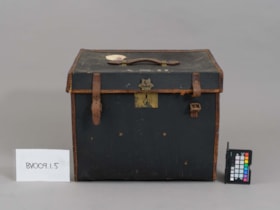
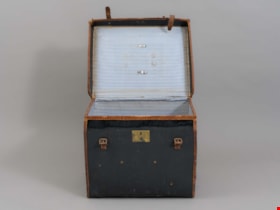
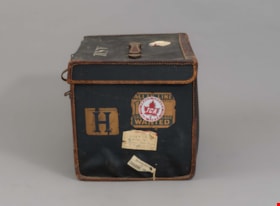
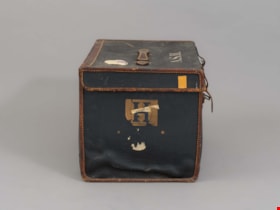
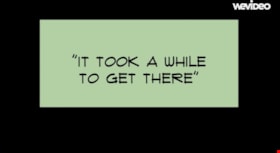
![Jack and Edith with Aunt Rita on boat, [1939] thumbnail](/media/Hpo/_Data/_BVM_Images/2016/2016_0046_0098_001.jpg?width=280)
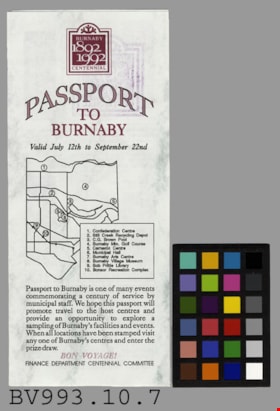
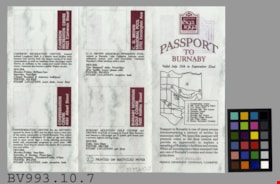
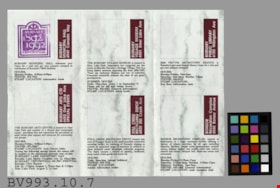
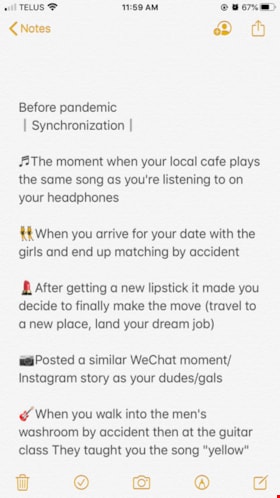
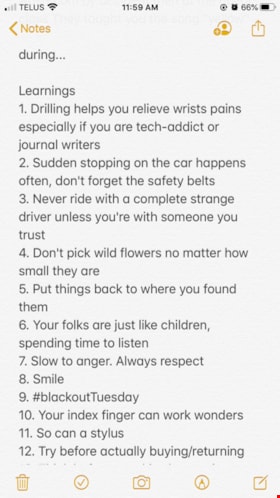
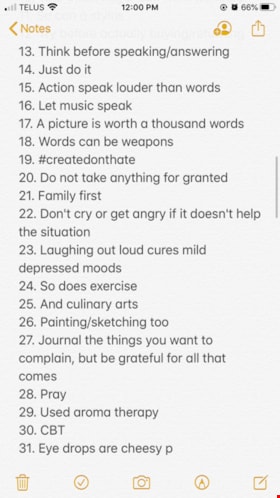
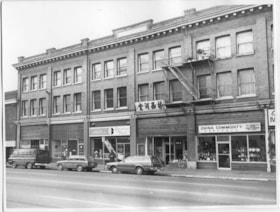
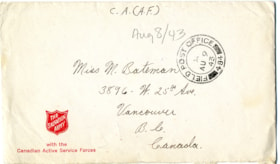
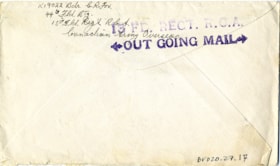
![Letter from Jesse Love to Dot Love, [1910] (date of original), photographed 1979 thumbnail](/media/hpo/_Data/_BVM_Images/1977/197900400004.jpg?width=280)
![Letter from Jesse Love to Dot Love, [1910] (date of original), photographed 1979 thumbnail](/media/hpo/_Data/_BVM_Images/1977/197900400005.jpg?width=280)
